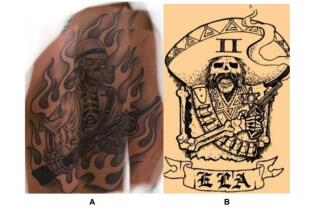A Clean Slate, a Second Chance
- Share via
No matter what words or pictures or language it might use, to most of the world a prominent tattoo conveys the same message:
Loser.
Those skin adornments might look cool in the tattoo shop or among like-minded friends, but when the proud owner shows up for a job interview--or a courtroom appearance--they can turn into a real liability.
That’s why more than 1,000 Ventura County residents have taken advantage of a gang-tattoo removal clinic offered at various locations since 1994--including a 3-year-old boy and a 62-year-old woman.
The program was started in Port Hueneme to help former gang members start a new life. The service was offered in Santa Paula last month and last week for the first time in Thousand Oaks.
The laser procedure is privately funded by the Landon Pediatric Foundation, Helping Hands Foundation and the Lawrence P. Frank Foundation, which gives more than $25,000 a year for the equipment, dressings and the costs of running the clinic.
Although the service doesn’t cost money for those having tattoos removed, it doesn’t come free. Each man or woman is required to contribute 40 hours of community service to nonprofit organizations in return for the tattoo removal. Many of them will have to undergo additional treatments once a month for three or four months to completely remove a tattoo.
Last weekend Monica Franco, a 27-year-old mother of three, was one of a dozen people who came to the Conejo Valley Family Care Center eager to remove gang tattoos and start a new life without the markings that once made them feel proud and tough.
Removing the 10-year-old tattoos from her hands and wrists will help Franco completely sever ties with the Oxnard gang she left behind when she moved to the Conejo Valley with her children.
“I’m getting these off out of respect for my kids,” she said. “I don’t want them to think it’s a cool thing to do. My 7-year-old girl just asked me if she can get a tattoo. I was shocked. I said, ‘No way.’ ”
For generations, insignias tattooed on the neck, arms and legs have been used to flaunt gang affiliation and separate the insiders from the outsiders. That backfires when the wearer of the tattoo decides to leave the gang--or to seek work in the business world.
It can also backfire should the tattooed person be charged with a gang-related crime.
“Some gang members are getting away from it, because the tattoos can be shown to a jury” as evidence of gang membership, Santa Paula Police Officer Mike Dedecker told The Times last month.
As is the case with many things done under peer pressure, it is much easier to get a tattoo than to get rid of one.
This worthwhile program is helping to give hundreds of Ventura County residents a second chance at making a good first impression.
More to Read
Sign up for Essential California
The most important California stories and recommendations in your inbox every morning.
You may occasionally receive promotional content from the Los Angeles Times.













